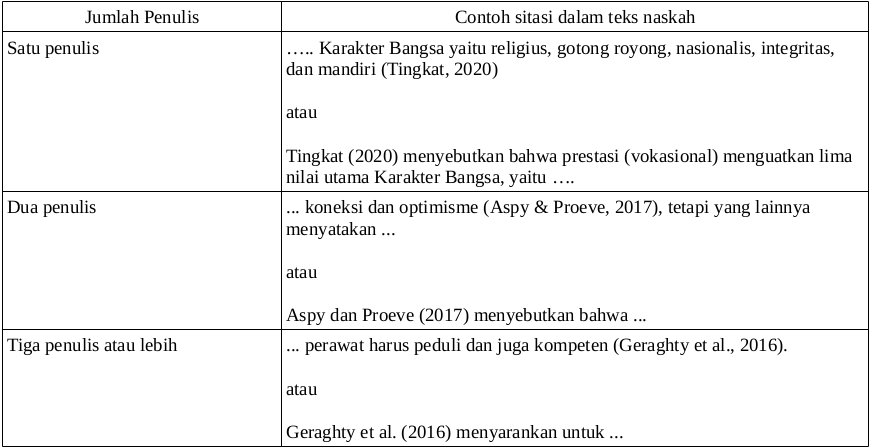Author Guidelines
A. Guidelines for Manuscript Writing
- Contains scientific texts on the development of learning, measurement and evaluation of education, and management of education.
- Must use the sample script journal template that has been provided.
- The manuscript is written in standard Englsih according to the enhanced spelling.
- Writing from the results of research and application of theory. Manuscripts must be original (never published) and written by researchers or research teams using Indonesian or English.
- The manuscript is made on A4 size paper, typed with 1 (single) space using the Microsoft Word word processing program, Garamond letter.
- The procedures for writing the research results are arranged in the following order (according to the template): Title, Author's Identity, Abstract, Introduction, Methods, Results and Discussion, Conclusions, Acknowledgments (optional) and Bibliography. The length of the full paper is 14-15 pages and the word count between 5,500-6,000 words.
- Title: Short and clear (no more than 14 words), written with capital letters.
- Author's Identity: The author's name is written in full (not abbreviated) without a title, name of institution, city of origin of the institution, country of origin of the institution, and email address of the author. If there is more than 1 author, then the 2nd, 3rd author and so on are written under the first author in sequence (see manuscript template).
- Abstract: Abstracts are equipped with key words sorted according to their importance. The abstract contains a summary of the manuscript (max 200 words), including all the writings without trying to detail each part. Avoid using abbreviations.
- Introduction: Contains the scope, background, objectives and benefits of research. This section should provide a background so the reader can understand and assess the results of the study without reading previous reports relating to the topic. Take advantage of libraries that can support the discussion.
- Methods: It should be described in detail and clearly about the materials used and the workings carried out, including statistical methods. The way the work is presented should contain sufficient information to enable the research to be repeated successfully.
- Results and Discussion: Presented together and discuss clearly the results of research. Can be presented in written form in a script, table, or picture. Reduce the use of graphics if this can be explained in the text. Limit the use of photos, present photos that clearly illustrate the results obtained. Figures and tables must be numbered and quoted in the manuscript. Photos can be sent in 4R size. The cost of loading color photos will be borne by the author. The graph of the results of data processing is sent in a separate file from the scientific manuscript file and is accompanied by the name of the program and the basic data for the preparation of the graph. The discussion presented should contain an interpretation of the results obtained and a discussion relating to previous research reports. It would be better if the reference used comes from the Journal. Avoid repeating statements that have been submitted on methods, results and other information that has been presented in the introduction.
- Conclusion: Presented separately from the results and discussion.
- Acknowledgments: Can be presented if deemed necessary. Aimed at funding research and giving awards to institutions and individuals who have helped research or the process of scientific writing.
- Bibliography: Arranged alphabetically by name and year of publication. Abbreviations of magazines / journals based on the procedures used by each journal. List of scientific journal/magazine references (last 5 years) at least 80% and text books 20%. Use the Mendeley application to help write the citation format (APA 7th edition).
- All manuscripts were reviewed in a blind-review by the reviewers appointed by the editor according to their expertise and the manuscript had met the tolerance limit of the percentage of plagiarism with online documents <= 25%. Script writers are given the opportunity to make improvements (revisions) of the manuscript based on recommendations/suggestions from bestari partners and implementing editors. Certainty of loading or rejection of the manuscript will be notified in writing via email.
- Everything related to licensing the citation or use of computer software for making manuscripts or other matters related to intellectual property rights carried out by the manuscript writer, along with the legal consequences that may arise because of it, are the full responsibility of the manuscript writer.
B. Reference Bibliography
To maintain the consistency of writing a bibliography, it is strongly recommended that the writer use the standard reference management application, one of which is Mendeley. The source is written by following the procedures (style) issued by APA (American Psychological Association 7th edition).
We recommend to use:
Examples of writing In-text refencing are as follows.

Examples of writing a reference list are as follows.
Book

Journal Articles

C. Guidelines for Submission of Manuscripts
-
The manuscript is submitted via the Make a Submissions link on the right sidebar on this website with registering as a user first (if not already registered). If it is already registered, please log in to start sending the manuscript.
-
We do not serve manuscripts sent via email, for those who are beginners in operating the Open Journal System (OJS) application, please see the Learning OJS 3 page.
D. Downloads
Cara Pengiriman Artikel ke Jurnal IJED
Pedoman Penulisan Sitasi dan Daftar Pustaka pada Jurnal IJED

















